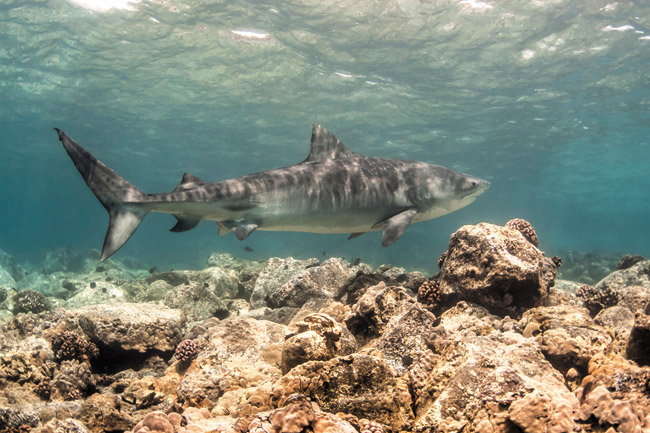State, Scientists Tracking Sharks

A tiger shark outside Honokohau Harbor on Hawaii Island in about 10 feet of water. Photo courtesy Deron Verbeck
Whether you’re a daily ocean user or a weekend warrior, there is no doubt the recent spike in shark attacks in Hawaiian waters has many asking, “What’s going on?”
The latest attack (as MidWeek was going to press Friday) happened last Wednesday near Punaluu Beach and Ninole Bay in Kau on Hawaii Island. According to Hawaii County Police, a shark in about 8 feet of water bit a 29-year-old bodyboarder from Captain Cook. Witnesses believe it was a 10- to 12-foot tiger shark. His injuries were not life-threatening.
Eight days earlier, in waters off Makena, Maui, 57-year-old Patrick Briney of Washington state was killed after a shark bit him. Briney was a part-time Maui resident and a retired Boeing engineer who had a passion for fishing. Briney was bitten on the leg while bait fishing on a kayak about a half-mile off-shore. It’s believed his legs were dangling over the side when the shark struck.
“He had a friend who was fishing nearby on a kayak who responded, retrieved him and got him over to a dive boat nearby that was anchored,” says Department of Land and Natural Resources director William Aila. “They put on a tourniquet and immediately tried to get him to shore.”
Briney was pronounced dead at Kihei Boat Ramp.
The fatal attack came just three days after a woman was bitten at Keawakpau Beach near Kihei. Her injuries were not life-threatening.
There now have been 14 shark attacks in Hawaii in 2013, eight of them have been in waters off Maui. Two have been fatal – both on the Valley Isle. In August, 20-year-old Jana Lutteropp of Germany died after a shark attacked her off Makena.
The attacks have left shark experts, marine biologists and state officials baffled.
“I’m going to be very honest with you, we don’t know. We don’t know the reasons for the spike,” says Aila. “We do know that it’s not just one shark. It’s likely different sharks. It’s likely different conditions. The shark bite last week was a smaller shark on a woman who was snorkeling. At this point we don’t have an answer for everyone who is asking why.”
What cannot be ignored is the startling amount of attacks in waters off Maui. While the eight incidents have generated a ton of national attention, tourism officials say the negative publicity hasn’t affected visitor arrivals – yet.
“We have not been able to see any negative impact thus far that we can equate directly to the shark attacks,” says Terry Vencl of Maui Visitors Bureau. “Maui county and the DLNR are currently in talks on a possible public outreach campaign about ocean safety and shark awareness.”
Many have speculated the reason for the increase in shark activity is because of overfishing and the dramatic increase in green sea turtles near the shoreline. (That said, as shark expert John Naughton emphasizes, tigers also are reef species.)
The attacks have also rekindled conversations Hawaii hasn’t heard in years, including the eradication of sharks. While the state has not considered shark hunts (at least not publicly), what it has done is partner with researchers with the Pacific Islands Ocean Observing System (PacIOOS) and the University of Hawaii to learn about the sharks in Hawaiian waters.
On Nov. 15, the group started tracking the movements of seven tiger sharks that were tagged off Kihei in October. Researchers say early data suggests not all sharks stay in one place. In fact, one tiger was tracked 300 miles southwest of Maui.
“We are excited to share the data with the public, but it’s for research purposes, not a warning system,” says Melissa Iwamoto, PacIOOS outreach and program coordinator. “This is only seven weeks into a two-year-long project, so it’s important to get enough data to make conclusions to make base management decisions on.”
More sharks will be tagged in coming months.
“We believe the study will give us information where the tiger sharks and other sharks that have been tagged, where they move, where they translocate to over a period of time,” says Aila, who adds that like the attacks, there’s no clear pattern to the movement of large tiger sharks on Maui.
For more information on the shark tracking system, go to oos.soest.hawaii.edu/pacioos/index.php.
rkmizutani@gmail.com





